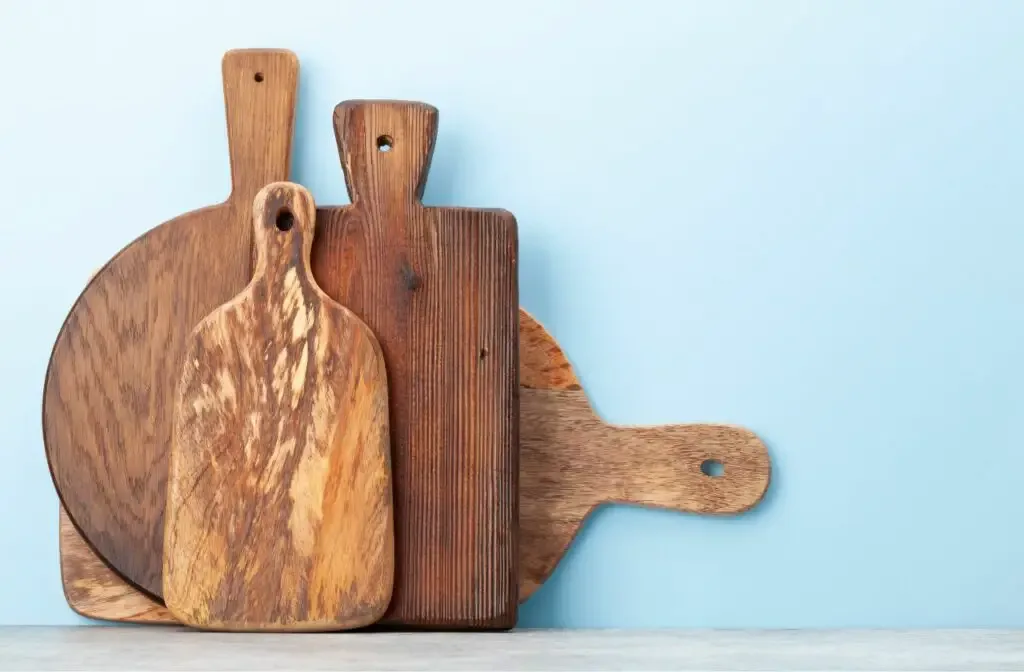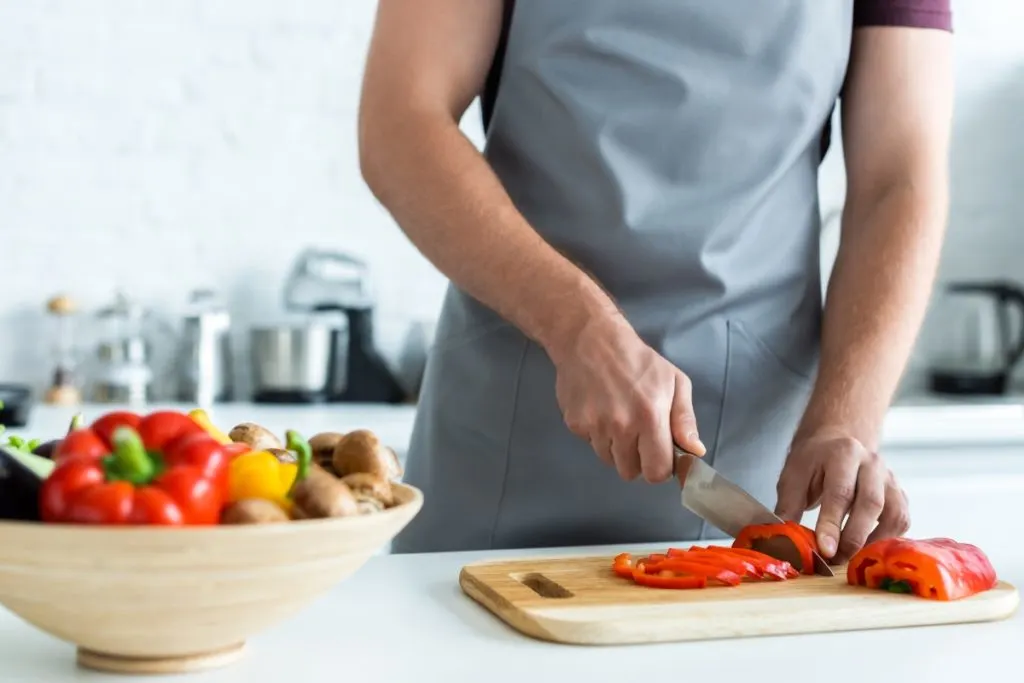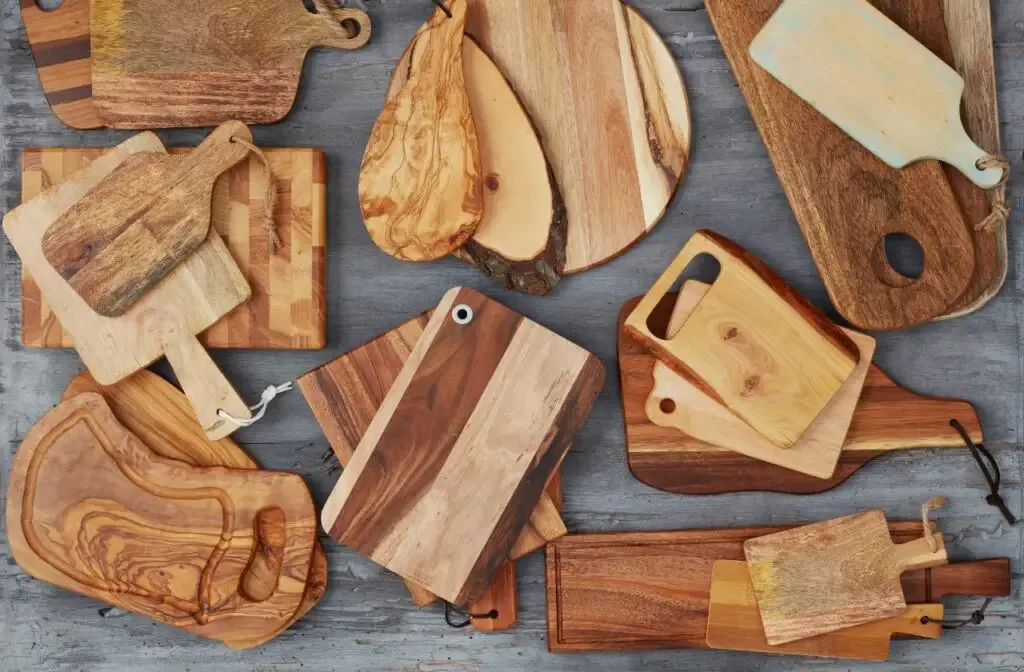As an Amazon Associate, we earn from qualifying purchases with no additional costs for you.
Many knife owners don’t realize the cutting board material’s importance in preserving their knives’ sharp edges. The choice of cutting board material is key, especially if you have expensive kitchen knives or knives with specific cutting board requirements. We will discuss the top 3 materials to choose from to use with your kitchen knives.
The best material for cutting boards to preserve the sharpness of your knives is wood, such as Maple or walnut. Boards made from high-density plastics have similar properties to wood, making knife-friendly cutting boards. Bamboo is suitable for mid-range knives but is too hard for Japanese knives.
Part of knife care means being aware of the surface on which you are using your kitchen knives. Some surfaces offer better protection for the cutting edge than others and will contribute to your knives staying sharper for longer and preventing unnecessary damage to the edge.
If you are interested in checking out the best wooden cutting board we recommend a cutting board made by the Virginia Boys Kitchens company. You can find it by clicking here (Amazon link).

What Cutting Board Material Is Best For (Japanese) Knives?
Kitchen knives are hardworking knives that often are used in difficult conditions or in a hurry. Sometimes, this means that people cut ingredients on surfaces that are damaging to their knife blades.
Neglecting to use a cutting board of the correct material will dull your knife very quickly and can crack and chip the steel on Japanese kitchen knives.
The chopping or cutting board material is important for any kitchen knife, but especially for Japanese kitchen knives. Japanese knives are hardened to higher levels of hardness than Western kitchen knives.
The additional hardness of the steel allows for a finer, sharper edge on the knife but compromises the flexibility of the steel. This means that the steel in Japanese knives is more brittle than knives made from other steel, making the edge prone to chipping and cracking when used on hard, inflexible cutting board surfaces.
Besides the possibility of chipping or cracking the edge, a hard cutting board surface will dull the sharp edge of any kitchen knife, whether it is a Japanese kitchen knife or not. Consequently, the correct cutting board choice can extend your knife’s life by reducing the sharpening frequency required.
BTW: If you are interested in buying the best cutting board, you can find our recommendations below:
- The best overall: Virginia Kitchen Boys Cutting Board (Amazon link). This fantastic cutting board is made from sustainable walnut wood from the United States and brings almost perfect safety when cutting with your knives.
- Alternative: Yoshihiro Cutting Board (Amazon link). Professional traditional Japanese cutting board that chefs around the world use.
- Cheaper option: Shun Cultery Cutting Board (Amazon link). Another Japanese cutting board stands out, especially for its simplicity and affordable price.
Cutting Board Choices To Avoid
Certain materials should never be used in the kitchen for cutting or chopping ingredients with your kitchen knives.
Some of these materials look good in the kitchen and are marketed as lasting longer and being easier to clean, but they are damaging to your knives.
Cutting boards made from the following materials should be avoided.
- Metal. Countertops, trays, dishes, and cutting boards made from steel or aluminum should not be used as a cutting surface for your knives. They will dull the sharp edge on your knives after a single use, causing the edge to roll over.
- Ceramic. Ceramic cutting boards are rigid and hard and will dull your knife’s edge and chip or crack Japanese knives.
- Glass. Glass cutting boards were fashionable for a while and look classy in the kitchen, but they are bad news for knife edges. Glass surfaces will roll the sharp edge of a knife or chip the edge.
- Stone. Granite or marble cutting boards are another material that has recently been popular as a cutting surface, but these materials are detrimental to your knives.
So, which materials make the best choice to use with your Japanese and other kitchen knives without causing damage to the edge?
Is A Bamboo Cutting Board Good For Knives?
Bamboo is another material that has seen a resurgence as a cutting board alternative for the kitchen, but are these boards suitable for use with your treasured kitchen knives?
Bamboo is a “green” material, making it a popular choice from a renewable resource perspective. Bamboo is a grass material rather than wood, so no deforestation happens when harvesting bamboo.
Considering that bamboo is environmentally friendly, durable, and easy to clean, does it make for a good cutting board material?
Bamboo is a very hard material, significantly harder than wood. This feature contributes to the durability of the material but also its unsuitability for certain knives.
Bamboo is too hard to be used as a cutting board for Japanese knives. The hardness of the material can chip or crack the steel on the knife’s edge.
Bamboo should only be selected as a cutting board for mid-range kitchen knives and not for high-end, expensive ones.
TIP: Rust is a known problem on any knife in the kitchen, which requires maintenance and a prevention strategy. Check out the complete guide in the article below:
6 Proven Ways On How To Prevent Rust On Kitchen Knives
Is Wood Or Plastic Cutting Board Better For Knives?

Wood and plastic are the other materials commonly used as cutting boards in the kitchen. How do these materials fare as a cutting board to protect the sharp edges of your knives?
Are Wood Cutting Boards Good For Knives?
Wood is a natural product used as a cutting board material for centuries. However, this does not mean that all wood cutting boards are good for knives or use in the kitchen!
Softwoods such as pine are generally not suitable for use as a cutting board. The wood is not dense enough to prevent fluids and bacteria from penetrating deep into the wood. This makes softwood cutting boards susceptible to cracking and splitting, absorbing odors, and difficult to keep acceptably clean and germ-free.
The softness of woods like pine means that the knife will cut into the wood fibers, reducing the life of the board and increasing the possibility of splinters or wood shards ending up in your food.
Hardwoods make a better choice for cutting board material, but some hardwoods are too hard and can damage the edge of your knife as easily as a glass or granite cutting board.
The best wood for making cutting boards that are both durable and knife-friendly include Maple, walnut, and cherry wood.
Are Plastic Cutting Boards Good For Knives?
Plastic can be a somewhat controversial material choice for a cutting board. Many purists would balk at using plastic as a surface for cutting and chopping ingredients, but the fact is some plastics are perfect for the job.
If you opt for a plastic cutting board, selecting a high-quality board made from the right type of plastic is important. Cheap plastic cutting boards can flake with age or with exposure to acidic food juices, resulting in small bits of plastic entering your food.
High-density plastics are better cutting board material than cheap, low-density plastics that will be sliced by the knife’s edge or compromised by fluids from the ingredients.
Most professional chefs prefer the feel of wood cutting boards to plastic ones, but high-density plastic has very similar characteristics to wood. The plastic has a certain amount of flex or give to it, which protects the knife’s edge, even when the knife is used with more pressure than usual on difficult ingredients.
Some of the features of plastic cutting boards that increase their popularity are that they are non-porous, so they are easy to clean and do not harbor bacteria.
They can be washed by hand or placed in the dishwasher, where the high heat effectively disinfects the cutting board. They also do not require regular maintenance and seasoning like wood cutting boards.
One of the most attractive aspects of plastic cutting boards is the price. They are significantly cheaper than a good wooden cutting board. The lower price of plastic cutting boards makes it easier to have multiple cutting boards in the kitchen designated for certain ingredients to prevent cross-contamination of ingredients.
A disadvantage of plastic cutting boards is they are often lightweight and more slippery than other cutting board types. This drawback makes them difficult to keep in place, especially when the countertop is wet. Placing a damp dishcloth under the cutting board will help to prevent it from slipping on the kitchen countertop.
TIP: Sharpening is an important part of knife care, but it also benefits several aspects of knife use. Find out the main reasons why to sharpen knives before use in the article below:
4 Reasons Why It Is Important To Sharpen A Knife Before Use
Best Types Of Cutting Boards For Knives

It may be difficult to find cutting boards made from materials that will help to protect your knives and preserve their sharpness.
We have put together a few appropriate cutting boards that we highly recommend as a good choice for all kitchen knives, including Japanese knives.
Virginia Boys Kitchens Walnut Cutting Board
The Virginia Boys Kitchens cutting board is a trusted product made in Virginia, USA, and sourced from sustainably grown walnut trees grown in the USA.
You can use your Virginia Boys Kitchen Walnut Cutting Board (Amazon link) immediately upon receiving it. The board is preseasoned with the company’s own blend seasoning oil, which includes fractionated coconut oil. The food-safe seasoning oil means your cutting board is ready to be used immediately after unboxing and is free from any unnatural substances.
The straight, medium-hard grain of the walnut wood board makes it a perfect cutting surface for the kitchen that will not dull your expensive kitchen knives.
The walnut cutting board is sturdy and thick, reducing the risk of it warping, cracking, or splintering. The cutting board is reversible, so both sides can be used without the need to clean it first. The quality of the material means the board will last you for years if it is properly maintained.
As a commitment to the product’s sustainability, the company plants an additional tree after every purchase of one of its products.
The proprietary oil used to season the boards, Virginia Boys Kitchens Cutting Board Oil (Amazon link), can be purchased separately.
This food-safe oil conditions and protects any wood cutting board or butcher block to extend its life and reduce the absorption of food odors and bacteria. The oil is based on all-natural ingredients, including fractionated coconut oil, orange essential oil, and rosemary extract.
Shun Cutlery Large Hinoki Cutting Board
Shun Cutlery is a respected manufacturer of quality Japanese kitchen knives. When a knife maker produces a cutting board, you know that the product is knife-friendly and designed to preserve the cutting edges on your expensive knives.
The Shun Cutlery Large Hinoki Cutting Board (Amazon link) is ideal for use with all Shun knives as well as other Japanese and Western style kitchen knives. The medium-soft wood offers the right amount of flex while cutting, which helps keep your knife edges sharp.
The Shun cutting board is made from hinoki, which is a Japanese cypress wood desirable for its beautiful light color and the natural, delicate fragrance of the wood. The Forest Stewardship Council certified the product as being harvested using sustainable foresting practices.
You may be concerned that the wood’s light color will stain easily, but the wood naturally resists staining. You can further reduce the possibility of staining by wetting the board down each time before you use it.
If the wood does retain some stains, it is easily cleaned by cutting a lemon in half and rubbing the cut side across the stained area.
The board is 17.75 inches by 11.75 inches, making it ideal for most kitchen operations where a cutting board is needed.
Yoshihiro Hi-Soft High-Performance Professional Grade Cutting Board
If you prefer a plastic cutting board for its easy maintenance and cleaning but want a product that is good for your knives, then this cutting board is what you need.
The Hi-Soft cutting board is a product from another renowned Japanese knife manufacturer, Yoshihiro Cutlery.
The cutting board is made from soft polyvinyl acetate and has proven to be a perfect material for quality, high-carbon steel knives such as Japanese kitchen knives. The high-quality synthetic material is specifically designed to reduce impact stress on your hand and on your knife’s edge.
The higher the quality of your knives, the higher the quality your cutting boards need to be to prevent damage to the knives. The cutting board is designed with sushi chefs in mind who use single-bevel sashimi knives that have a very sharp but delicate edge.
The Yoshihiro Hi-Soft High-Performance Professional Grade Cutting Board (Amazon link) is created for use with high-end knives, making it suitable for any knife in your kitchen.
The plastic material does not absorb odors, and cleaning is a simple matter of washing the cutting board in warm, soapy water or placing it in the dishwasher. The Yoshihiro plastic cutting board is available in a range of sizes to suit any kitchen!
Is It Worthwhile Buying A Good Cutting Board?

When it comes to kitchen essentials, the value of a high-quality cutting board cannot be overstated. While it might be tempting to opt for a cheaper alternative, investing in a good cutting board is not only beneficial for the longevity and efficiency of your kitchen knives but also proves to be better value for money in the long run, provided it is well-maintained.
The Downside of Cheap Cutting Boards
Cheap cutting boards often come with a host of problems that can negatively impact both your knives and your cooking experience. Typically made from lower-quality materials, these boards can dull the edges of your knives rapidly.
When a knife blade repeatedly comes into contact with a hard or abrasive surface, it can lead to the rolling or chipping of the blade’s edge, necessitating more frequent sharpening. Additionally, cheaper boards are often less durable and prone to warping, cracking, or harboring bacteria in deep scratches, leading to potential hygiene issues.
Benefits of High-Quality Cutting Boards
On the other hand, a good-quality cutting board made from materials like end-grain wood or high-density plastic can significantly extend the life of your kitchen knives.
These materials provide a softer, more forgiving surface for the knife blade, reducing the rate at which the blade dulls. This means less sharpening and, consequently, a longer lifespan for your knives.
High-quality cutting boards are designed with both functionality and longevity in mind. They often feature properties like self-healing and scratch resistance, which not only preserve their appearance but also prevent the growth of bacteria. This makes them more hygienic and safer for food preparation over time.
Long-Term Value and Care
While the initial investment in a good cutting board might be higher, the long-term value is undeniable.
A well-crafted cutting board can last for years, even decades, with proper care. This involves regular cleaning, avoiding excessive exposure to water and heat, and periodic oiling or conditioning to maintain the wood or plastic.
In contrast, the frequent replacement and the potential damage to knives associated with cheap cutting boards can lead to higher costs over time.
Investing in a high-quality cutting board is a wise decision for any kitchen. It not only protects and preserves your kitchen knives but also offers better hygiene, durability, and long-term savings.
The initial cost is outweighed by the extended lifespan of both your knives and the board itself, making it a worthwhile investment for any home cook or professional chef.
Conclusion
A quality cutting board is not an optional extra for your kitchen but a necessity to keep your kitchen knives in prime condition. The better the quality knives you own, the better the quality cutting board you should have to protect the cutting edges of your knives.
Bamboo is a suitable cutting board choice for cheaper knives, but the preferred choice for better, high-end knives is wood cutting boards or boards made from a suitable plastic material.
TIP: Any surface used in the kitchen for food preparation must be kept scrupulously clean. Find out the best methods for cleaning wood and bamboo cutting boards in the article below:
4 Proven Methods: Cleaning Wooden & Bamboo Cutting Boards
